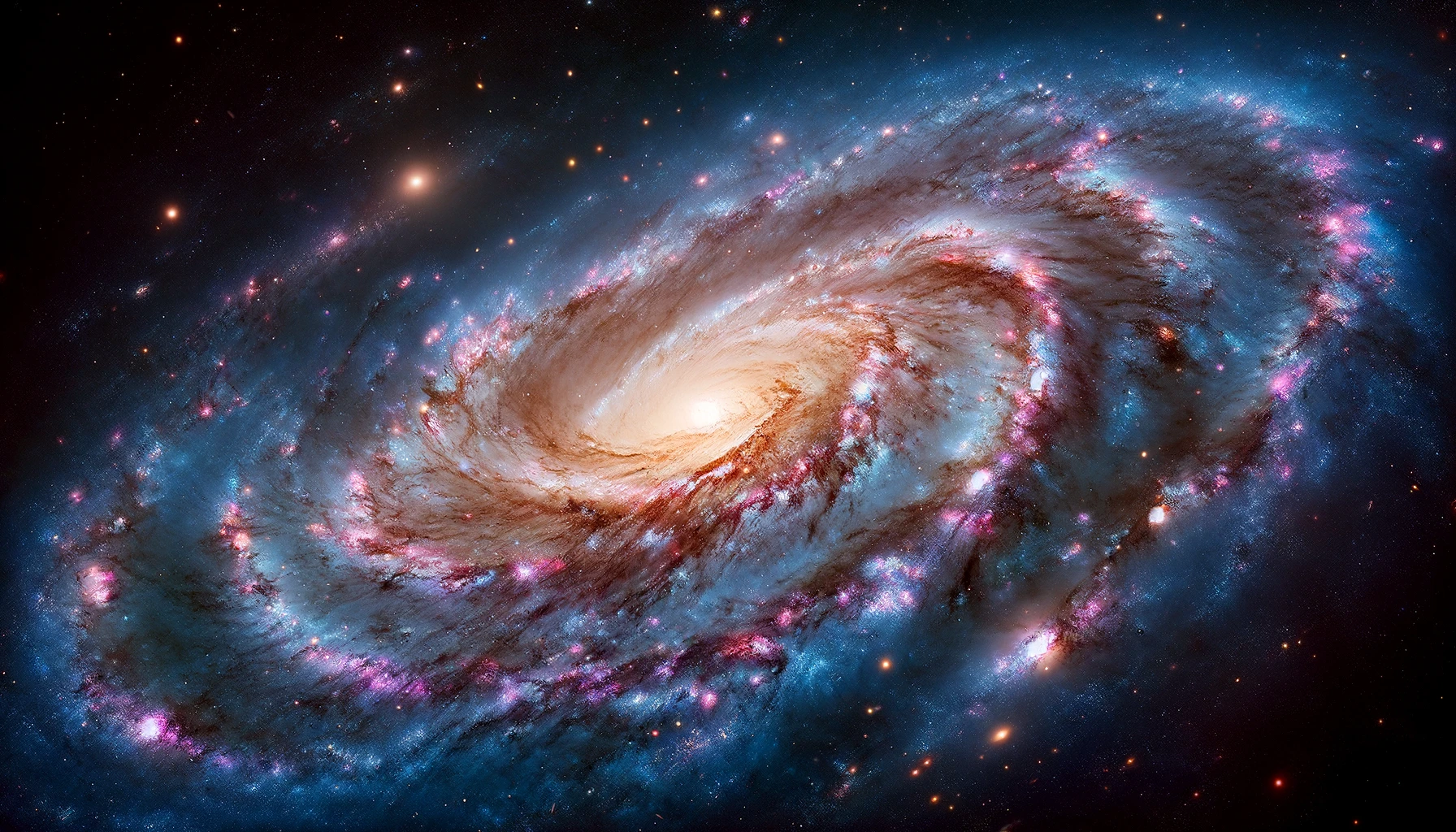From the fiery heart of our sun to the swirling galaxies beyond, the universe is teeming with awe-inspiring celestial objects. These diverse entities hold the key to understanding the cosmos, its formation, and its ongoing evolution. Here at Astronomyo, we embark on a captivating journey to explore these celestial wonders, deciphering their mysteries and igniting your passion for the universe
Let us guide you through the fascinating realms of our solar system, the dazzling world of stars, and the breathtaking landscapes of galaxies far and wide. Join us as we delve into the formation, composition, and unique characteristics of these celestial objects, unlocking the secrets they hold.
Our Solar System

Our cosmic journey begins within the familiar confines of our solar system, a diverse collection of celestial bodies bound by the Sun’s immense gravitational pull. At the center of this celestial dance lies the Sun, the star that fuels life on Earth and holds the key to understanding our planetary system.
The sun

The Sun is a massive ball of hot plasma, primarily composed of hydrogen and helium. Its immense gravity orchestrates the intricate ballet of planets, moons, and other objects that orbit around it. Unlike the twinkling points of light we see at night, the Sun is a self-luminous star, generating its own light and energy through a process called nuclear fusion.
The Sun’s energy, in the form of heat and light, sustains life on Earth, driving essential processes like photosynthesis and influencing our planet’s climate.
Key Facts about the Sun:
- Size: 109 times the diameter of Earth
- Temperature: Surface temperature of about 5,500 degrees Celsius (9,932 degrees Fahrenheit)
- Age: Roughly 4.6 billion years old
- Life Cycle: Currently in its main sequence stage, fusing hydrogen into helium.
The Planets
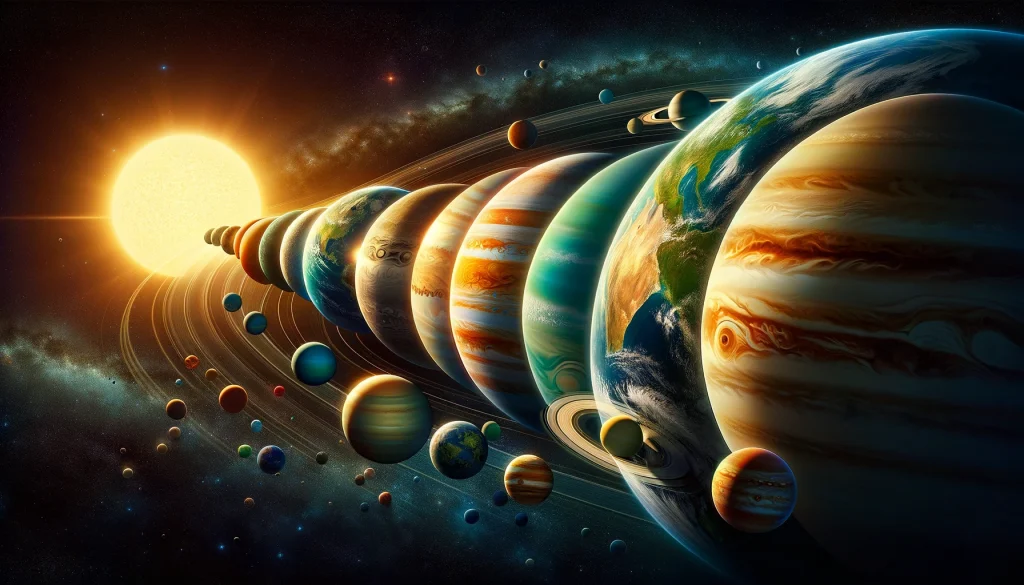
Unveiling the Diverse Worlds of Our Solar System: The Planets Beyond the Sun, our cosmic neighborhood boasts a captivating collection of planets, each with its unique characteristics and story to tell.
Here, we embark on a brief tour of these celestial bodies, exploring their individual personalities and the fascinating diversity they offer within our solar system.
1. The Terrestrial Planets:
Closest to the Sun reside the four terrestrial planets, aptly named for their rocky composition similar to Earth. These planets, Mercury, Venus, Earth, and Mars, share several characteristics, including a solid surface, presence of craters, and atmospheres (except Mercury).
- Mercury: The smallest and closest planet to the Sun, Mercury endures scorching temperatures and rapid rotation.
- Venus: Earth’s closest neighbor, shrouded in a thick, dense atmosphere of carbon dioxide, creating a scorching greenhouse effect.
- Earth: Our home planet, uniquely suited for life with its liquid water oceans, diverse atmosphere, and moderate temperatures.
- Mars: The Red Planet, a world of canyons, volcanoes, and polar ice caps, holding clues about the potential for past or present life.
2. The Gas Giants:
Venturing further outward, we encounter the awe-inspiring gas giants, massive planets primarily composed of hydrogen and helium.
These colossal worlds, Jupiter, Saturn, Uranus, and Neptune, boast distinct features and hold their own retinue of moons.
- Jupiter: The largest planet in our solar system, a swirling gas giant with a prominent Great Red Spot and numerous moons, including the volcanic moon Io and the icy Europa.
- Saturn: The ringed giant, renowned for its majestic system of rings composed of ice and dust particles, and moons like the icy Titan with its own atmosphere.
- Uranus: An ice giant tilted on its side, radiating a faint blue color due to atmospheric methane, and a unique ring system.
- Neptune: The farthest planet from the Sun, another ice giant with a distinctive blue hue and supersonic winds.
3. The Dwarf Planets:
Our solar system also encompasses a collection of dwarf planets, celestial bodies that meet most of the criteria of a planet but haven’t cleared the neighborhood around their orbit. Pluto, the most famous dwarf planet, along with others like Eris and Ceres, offer intriguing insights into the formation and evolution of our solar system.
This section provides a brief overview of the planets. You can expand upon each planet with further details about its size, atmosphere, moons, and any unique features or ongoing exploration efforts.
Moons

Our journey through the solar system wouldn’t be complete without delving into the captivating world of moons. These celestial bodies, orbiting planets and dwarf planets, come in a remarkable variety of sizes, compositions, and features, adding another layer of complexity and intrigue to our cosmic neighborhood.
A Spectrum of Diversity:
Moons range from the colossal, like Jupiter’s Ganymede, the largest moon in our solar system, exceeding even Mercury in size, to the miniscule, like Phobos and Deimos, the potato-shaped moons of Mars. Their compositions vary greatly, with some primarily rocky, like Earth’s Moon, while others are icy worlds like Jupiter’s Europa and Saturn’s Enceladus, harboring vast oceans beneath their icy surfaces.
Fascinating Examples:
Among the fascinating moons of our solar system:
- Jupiter’s Europa: This icy moon captures the imagination with its potential for harboring a subsurface ocean, possibly conducive to life as we know it. Its smooth, cracked surface hints at a dynamic and potentially habitable environment beneath the ice.
- Saturn’s Titan: This intriguing moon boasts a thick atmosphere, the only moon in our solar system known to have a stable, planet-like atmosphere. This dense atmosphere creates a hazy surface and intriguing weather patterns, including methane rain and lakes.
- Io (Jupiter) and Enceladus (Saturn): These moons, known for their volcanic activity, spew plumes of volcanic material, hinting at internal heat sources and ongoing geological processes.
Beyond the Examples:
The diversity of moons extends far beyond these few examples. Each moon holds its own story, offering valuable insights into the formation and evolution of planetary systems. From the active volcanic landscapes of Io to the potential for hidden oceans beneath the icy surfaces of Europa and Enceladus, moons continue to be a major focus of exploration and scientific curiosity.
4. Other Solar System Objects
While planets and moons dominate our solar system narrative, they share the celestial stage with a diverse collection of smaller objects, each playing their role in the ongoing story of our cosmic neighborhood.
1. Asteroids: These rocky remnants from the formation of our solar system primarily reside in the asteroid belt, located between Mars and Jupiter. Although most are small, asteroids can vary significantly in size, with some even exceeding the size of dwarf planets.
2. Comets: These “dirty snowballs” of ice and dust, originating from the fringes of our solar system, leave behind mesmerizing trails of gas and dust as they approach the Sun. Occasionally, some comets put on spectacular displays visible from Earth, like the iconic Halley’s Comet.
3. Other Smaller Bodies: The solar system also encompasses a variety of other intriguing objects, including:
- Centaurs: Icy bodies with characteristics of both asteroids and comets, residing in the outer solar system.
- Kuiper Belt Objects: A vast collection of icy objects beyond Neptune’s orbit, including Pluto and other dwarf planets.
- Oort Cloud: A theorized sphere of icy objects at the farthest reaches of our solar system, the potential source of long-period comets.
These smaller objects offer valuable insights into the early formation of our solar system and the ongoing processes shaping its structure. While they may be dwarfed by the larger planets and moons, their presence adds another layer of complexity and intrigue to the captivating tapestry of our cosmic neighborhood.
Stars
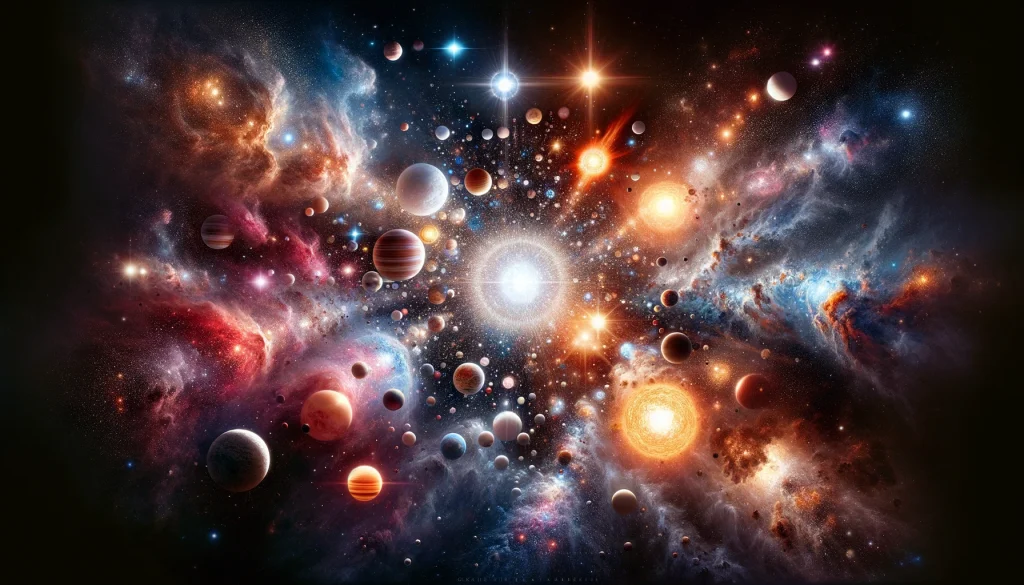
Stars, the celestial beacons illuminating the night sky, hold the key to understanding the universe’s evolution and the potential for life beyond our world. From the fiery birth of a newborn star to its dramatic transformation and eventual demise, these celestial powerhouses captivate our imagination and inspire scientific exploration.
Stellar Formation
The journey of a star begins within vast, swirling clouds of gas and dust, primarily composed of hydrogen and helium, scattered throughout the universe. These clouds, known as nebulae, become the nurseries for future stars. Within these nebulae, gravity begins to play a crucial role. As denser regions within the cloud collapse under their own gravity, the material heats up and begins to spin faster. This process continues, drawing in more and more surrounding material until a core of immense pressure and temperature forms at the center – the protostar.
The Ignition Spark:
As the protostar’s core density and temperature increase further, a critical point is reached where nuclear fusion, the process that powers stars, can ignite. In this process, hydrogen atoms are fused into helium, releasing tremendous amounts of energy. This newfound energy outward counterbalances the gravitational pull inwards, achieving a state of hydrostatic equilibrium, marking the birth of a star.
The Stellar Cradle:
The surrounding gas and dust continue to fall onto the newly born star, feeding its growth and influencing its final mass. Eventually, the surrounding material dissipates, revealing the star in all its glory, ready to embark on its journey through the vast expanse of the universe.
Stellar Classification
Stars, despite their dazzling appearance, come in a remarkable variety of sizes, temperatures, and lifespans. Astronomers have devised a classification system, the Morgan-Keenan (MK) classification, to categorize stars based on their surface temperature and luminosity (brightness). This system, denoted by letters O, B, A, F, G, K, and M, helps us understand the diverse characteristics and evolutionary stages of stars within our galaxy.
A Spectrum of Stellar Types:
- O Stars: The hottest and most massive stars, radiating intense ultraviolet light and playing a crucial role in the formation of nebulae.
- B Stars: Extremely hot and luminous, often appearing bluish-white and associated with star formation regions.
- A Stars: Hot and bright stars, ranging from bluish-white to white, and often found in young star clusters.
- F Stars: Moderately hot and bright, appearing white or yellowish-white, and common throughout the Milky Way.
- G Stars: Similar to our Sun, these yellow stars are of moderate temperature and luminosity, harboring potential for life in their habitable zones.
- K Stars: Cooler and dimmer than the Sun, appearing orange, and quite common in the galaxy.
- M Stars: The coolest and faintest stars, appearing red, and the most abundant type of star in the universe.
Beyond Temperature: The Role of Luminosity
The MK classification system further considers a star’s luminosity, which can vary significantly within each temperature class. Stars like our Sun, classified as G stars, can be further categorized as main sequence stars, giants, or dwarfs based on their luminosity and evolutionary stage. This additional layer of classification provides a more comprehensive understanding of a star’s characteristics and life cycle.
A Dynamic Journey:
Each type of star embarks on a unique journey through its lifespan, from its fiery birth in a nebula to its dramatic transformation and eventual demise. Understanding these stellar types and their diverse characteristics allows us to appreciate the vast and dynamic tapestry of the universe, where stars play a crucial role in the creation of the elements and the potential for life.
Stellar Evolution
Stars, the luminous giants of the universe, undergo a captivating transformation throughout their existence. From their fiery birth within nebulae to their dramatic final stages, stellar evolution paints a vibrant story of creation, transformation, and the potential for rebirth.
The Main Sequence: A Beacon of Stability
Following its birth, a star settles into the longest and most stable phase of its life, known as the main sequence. During this stage, the star generates energy through the process of nuclear fusion, converting hydrogen in its core into helium. The outward pressure generated by this fusion process balances the inward pull of gravity, maintaining a state of hydrostatic equilibrium. The Sun, currently around 4.6 billion years old, is in its main sequence phase.
Beyond the Main Sequence: Transformation and Beyond
As the star depletes its core hydrogen fuel, it begins to evolve beyond the main sequence. The path it takes depends heavily on its initial mass.
- Low-Mass Stars: Like our Sun, stars with a mass less than about 2.5 times that of the Sun eventually exhaust their core hydrogen. They then enter a red giant phase, where the outer layers expand and cool while the core contracts and heats up, initiating the fusion of helium into heavier elements. Eventually, they shed their outer layers, forming a beautiful planetary nebula and leaving behind a hot, white dwarf core.
- Medium-Mass Stars: Stars with a mass between 2.5 and 8 times that of the Sun follow a similar path but reach higher temperatures and become even larger red giants. They can further fuse elements beyond helium, leading to the creation of heavier elements like oxygen and carbon. In their final stages, they can explode in a spectacular supernova, leaving behind a neutron star or a black hole.
- Massive Stars: Stars exceeding 8 solar masses have a far more dramatic and explosive destiny. They go through rapid burning stages, fusing progressively heavier elements until they reach iron in their cores. As iron cannot release energy through fusion, the core collapses under its own gravity, triggering a colossal supernova explosion. This explosion can forge even heavier elements like gold and platinum, scattering them throughout the universe. The remnant left behind can be either a neutron star, incredibly dense and compact, or a black hole, an object with such immense gravity that not even light can escape its grasp.
The Stellar Legacy:
The evolution of stars plays a crucial role in shaping the universe. Stars not only illuminate the cosmos but also forge the elements necessary for life as we know it. Through their stellar winds and supernovae explosions, they distribute these elements throughout the galaxy, enriching the interstellar medium and paving the way for the formation of new stars and planetary systems.
Galaxies

Gazing upon the night sky, we often see individual stars scattered across the darkness. However, the universe holds a grander structure – vast collections of stars, gas, dust, and dark matter bound by gravity, known as galaxies. These island universes come in a variety of shapes and sizes, each offering a glimpse into the diverse tapestry of the cosmos.
Types of Galaxies
Astronomers classify galaxies based on their overall visual appearance. Here, we explore the three major types:
- Spiral Galaxies: These majestic structures, like our own Milky Way galaxy, boast a flattened disc with prominent spiral arms winding outwards from a central bulge. The disc primarily contains gas, dust, and young stars, while the central bulge harbors older stars. Spiral galaxies are further classified based on the presence or absence of a bar-shaped structure running through the bulge, creating barred spiral galaxies.
- Elliptical Galaxies: These elliptical-shaped galaxies lack the distinct disc and spiral arms of spirals. Instead, they appear smooth and featureless, with a concentration of stars towards the center. Elliptical galaxies are primarily composed of older, redder stars and contain relatively little gas and dust, suggesting minimal ongoing star formation.
- Irregular Galaxies: These galaxies defy easy classification, displaying a chaotic and irregular structure. They may have undergone interactions with other galaxies, leading to their distorted appearances. Irregular galaxies often contain a mix of young and old stars, gas, and dust, offering astronomers valuable insights into star formation processes.
Beyond the Big Three:
This classification system offers a simplified view of the galactic zoo. Some galaxies exhibit characteristics of multiple types, blurring the lines between categories. Additionally, astronomers have identified other, rarer types of galaxies, like dwarf galaxies – smaller, fainter companions to larger galaxies – and active galaxies, characterized by a supermassive black hole at their core, spewing out immense amounts of energy.
Our Galaxy – The Milky Way
Gazing at the Milky Way on a clear night sky, we witness a breathtaking band of light stretching across the heavens. This luminous band is not just a collection of randomly scattered stars but our home galaxy, a vast island universe teeming with billions of stars, gas, dust, and dark matter.
A Spiral Majesty:
Classified as a barred spiral galaxy, the Milky Way boasts a flattened disc with prominent spiral arms emanating from a central bulge. The Sun resides within one of these spiral arms, the Orion Arm, located roughly 27,000 light-years from the galactic center.
Compositional Breakdown:
The Milky Way is estimated to contain:
- Stars: Over 200 billion stars, ranging from massive blue giants to faint red dwarfs.
- Gas: Primarily hydrogen and helium, fueling ongoing star formation in the spiral arms.
- Dust: Composed of fine particles of ice and rock, playing a crucial role in the formation of stars and planetary systems.
- Dark Matter: A mysterious and invisible substance, thought to comprise the majority of the galaxy’s mass, influencing its structure and rotation.
Unveiling the Galactic Center:
At the heart of the Milky Way lies a supermassive black hole, known as Sagittarius A*, exerting a powerful gravitational influence on the surrounding stars and gas. This region is shrouded in dust, making direct observation challenging, but astronomers utilize various techniques to probe its secrets.
Our Galactic Neighborhood:
The Milky Way is not alone in the vast expanse of the universe. It resides within a cluster of galaxies known as the Local Group, which includes our closest galactic neighbor, the Andromeda Galaxy. Understanding our place within the Milky Way and the Local Group offers valuable insights into the structure and evolution of the universe as a whole.
Beyond the Milky Way
Our celestial journey wouldn’t be complete without venturing beyond the familiar confines of our Milky Way galaxy. As awe-inspiring as our galactic home may be, it is merely one among a staggering number of galaxies populating the vast and ever-expanding universe.
A Universe of Island Universes:
Estimates suggest there are hundreds of billions, if not trillions, of galaxies scattered across the observable universe. Each galaxy, like our own Milky Way, harbors billions of stars, forming a dazzling display of light and celestial phenomena. These island universes come in various shapes and sizes, from majestic spirals to the smooth ovals of elliptical galaxies, each holding its own story of formation and evolution.
A Glimpse into the Immeasurable:
The distances between galaxies are truly mind-boggling. The Andromeda Galaxy, our closest galactic neighbor, is roughly 2.5 million light-years away, highlighting the vastness of space. Astronomers utilize powerful telescopes and sophisticated techniques to peer deeper into the cosmos, revealing galaxies billions of light-years away, allowing us to witness the universe as it existed billions of years ago.
A Tapestry of Diversity:
Galaxies are not static entities; they evolve over time, interacting with each other, merging, and shaping the large-scale structure of the universe. Studying galaxies beyond the Milky Way allows us to gain a broader understanding of galactic formation and evolution, the diverse processes at play, and the potential for life elsewhere in the universe.
Beyond Our Galaxy
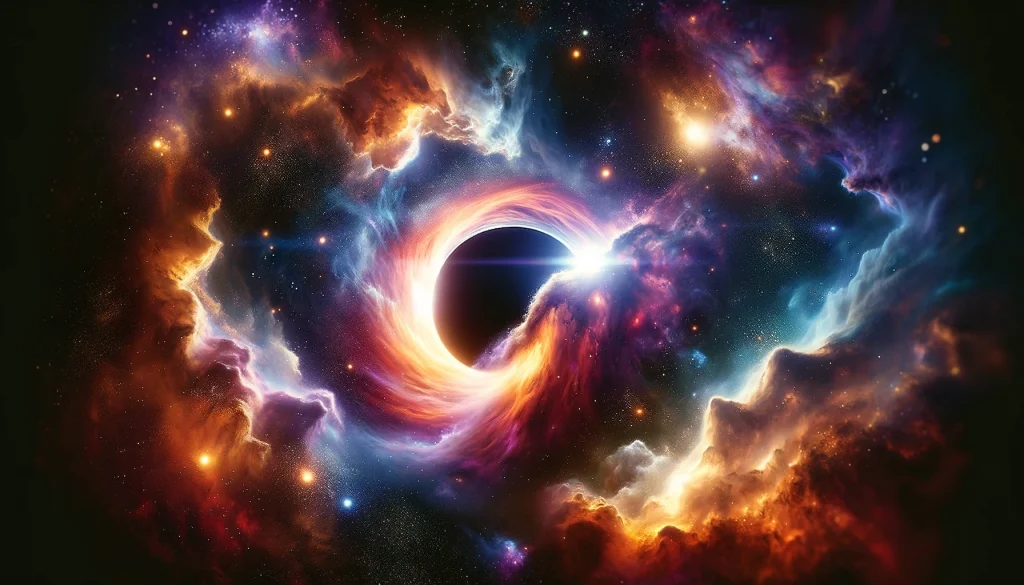
Our cosmic adventure extends beyond the boundaries of galaxies, inviting us to explore the fascinating realm of nebulae. These vast clouds of gas and dust, scattered throughout the universe, serve as the birthplaces of stars and play a crucial role in shaping the celestial tapestry.
From Stellar Dust to Dazzling Birthplaces:
Nebulae primarily originate from two main processes:
- Supernova Remnants: When massive stars reach the end of their lives in a fiery supernova explosion, they expel a substantial portion of their gaseous material into the surrounding space. This ejected material, enriched with heavier elements forged within the star, forms a supernova remnant nebula.
- Stellar Winds and Discarded Material: Even during their main sequence phase, stars shed mass through stellar winds. Additionally, young stars in their formative stages discard material as they collapse and condense. This ejected material combines in the interstellar medium to form vast nebulae.
Compositional Breakdown:
The primary components of nebulae are:
- Hydrogen: The most abundant element in the universe, providing the fuel for future star formation.
- Helium: The second most abundant element, present in significant quantities.
- Dust: Composed of tiny particles of ice and rock, playing a crucial role in the cooling and clumping of gas within nebulae, eventually leading to star formation.
A Spectrum of Nebular Diversity:
Nebulae come in a remarkable variety, each offering a glimpse into the dynamic processes shaping the universe. Here are some major types:
- Emission Nebulae: These brightly colored nebulae contain hot, young stars that have recently formed within the nebula. The energetic radiation from these stars excites the surrounding gas, causing it to emit light at specific wavelengths, creating vibrant colors. Examples include the Orion Nebula, a stellar nursery teeming with young stars.
- Reflection Nebulae: These nebulae do not emit their own light but rather reflect the light from nearby stars. The dust particles within these nebulae scatter the starlight, creating a soft, luminous glow. An example is the famous Trifid Nebula, showcasing a combination of reflection and emission nebulae.
- Planetary Nebulae: These are the colorful remnants of Sun-like stars nearing the end of their lives. As the dying star ejects its outer layers, they form a glowing shell around the hot, white dwarf core remaining. The Ring Nebula and the Cat’s Eye Nebula are iconic examples of planetary nebulae.
- Dark Nebulae: Unlike their luminous counterparts, dark nebulae are composed of dense clouds of cold gas and dust, so thick that they block light from passing through. These unseen giants play a crucial role in star formation by providing the dense material needed for stellar nurseries. The Horsehead Nebula, a dark nebula silhouetted against a background emission nebula, is a well-known example.
Black Holes
Our cosmic journey takes a dramatic turn as we delve into the realm of black holes, some of the most fascinating and enigmatic objects in the universe. These celestial giants possess gravity so extreme that not even light can escape their grasp. Black holes hold the key to unlocking some of the deepest mysteries of the cosmos, and scientists continue to explore their properties and influence on the universe.
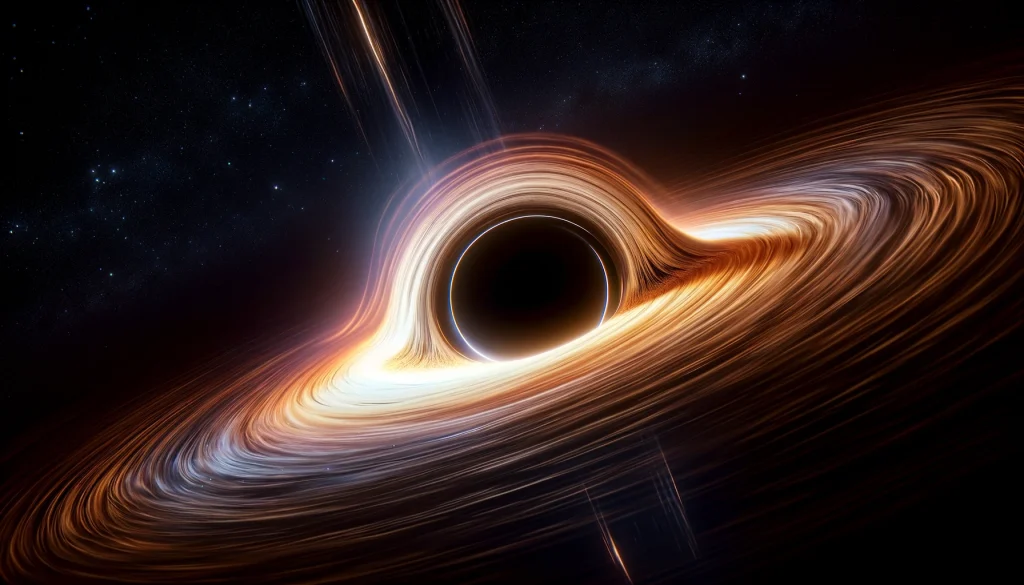
Gravity’s Ultimate Grip:
A black hole forms when a massive star collapses under its own gravity at the end of its life. This collapse compresses the star’s immense mass into an incredibly small region of space, known as a singularity. The gravitational pull of a black hole is so powerful that the escape velocity, the speed required to break free from its gravitational influence, exceeds the speed of light – the cosmic speed limit.
Event Horizon: The Point of No Return:
Surrounding the singularity lies a boundary called the event horizon. This is the point of no return; anything that crosses this invisible barrier, be it matter, light, or even information, is forever trapped within the black hole’s grasp. The immense gravity of a black hole warps the fabric of spacetime around it, creating this one-way gateway.
Beyond the Point of No Return:
While we cannot directly observe the interior of a black holes due to their light-trapping nature, scientists can study their influence on their surroundings. Black holes can interact with nearby matter in dramatic ways, pulling in gas and dust, forming swirling accretion discs that emit immense amounts of energy. In some cases, these interactions can also trigger powerful jets of matter propelled outward at near light speed.
A Universe of Mysteries:
Black holes continue to be a subject of intense scientific exploration. Astronomers utilize various techniques, such as studying the motions of stars and gas around them, the emission of X-rays, and gravitational waves, to probe their properties and shed light on their formation and behavior. The existence of black holes challenges our understanding of physics and gravity at the extreme, pushing the boundaries of scientific knowledge.
Matter and Dark Energy
As we embark on the final leg of our cosmic journey, we encounter two enigmatic concepts that continue to challenge our understanding of the universe: dark matter and dark energy. These invisible entities, while not directly observable, play a crucial role in shaping the universe’s structure and evolution, and their mysteries continue to fuel scientific exploration.
1. The Enigma of Dark Matter:
Dark matter, as its name suggests, remains invisible to our current telescopes and instruments. Despite its elusiveness, astronomers have strong evidence for its existence based on its gravitational influence. This invisible substance is thought to constitute about 27% of the universe’s mass, significantly outweighing the visible matter we can observe (stars, planets, gas, and dust).
The Invisible Architect:
The gravitational pull of dark matter shapes the universe in profound ways. It influences the rotation of galaxies, the formation of large-scale structures, and the behavior of matter within galaxies. Understanding the nature of dark matter is crucial for unlocking a deeper understanding of the universe’s evolution and the true extent of its mass and energy content.
2. The Expanding Enigma: Dark Energy
Dark energy, another enigmatic entity, is believed to be responsible for the universe’s accelerated expansion. This unseen force, constituting about 68% of the universe’s total energy content, is pushing galaxies further apart at an ever-increasing rate.
A Universe in Constant Expansion:
Observations suggest that the expansion of the universe is not constant but rather accelerating. Dark energy is thought to be the driving force behind this phenomenon, although its exact nature remains a mystery. Understanding dark energy is crucial for unraveling the ultimate fate of the universe, whether it will continue to expand forever or eventually collapse in on itself.
The Quest for Answers:
The existence of dark matter and dark energy presents some of the most significant challenges in modern physics and cosmology. Scientists are actively exploring various avenues to unravel their mysteries. This includes searching for new particles that could constitute dark matter, developing advanced telescopes and instruments to probe their subtle effects, and refining our understanding of the fundamental laws of physics at the largest scales.
Conclusion: A Universe Unveiling its Wonders
Our cosmic journey has taken us on a captivating exploration of astronomy, revealing the vastness and diversity of the celestial objects that paint the tapestry of our universe. From the fiery birth of stars to the majestic dance of galaxies, and beyond the boundaries of our own Milky Way, we have encountered objects that inspire awe and ignite our curiosity.
This exploration has merely scratched the surface of the countless wonders and mysteries the universe holds. Each celestial object we encounter, from the smallest asteroid to the most massive black hole, offers a unique story, a window into the ongoing processes shaping the cosmos.
Delving Deeper:
Our website is just the beginning of your astronomical voyage. We encourage you to utilize the resources at your disposal to delve deeper into specific topics that pique your interest. Explore our interactive simulations, informative articles, and engaging videos. Additionally, we provide links to external sources, trustworthy websites, and research institutions to further your exploration.
Remember, the universe is a vast and ever-expanding playground for inquisitive minds. Continue to ask questions, explore further, and let the wonders of astronomy ignite your passion for understanding our place in the grand cosmic dance.
